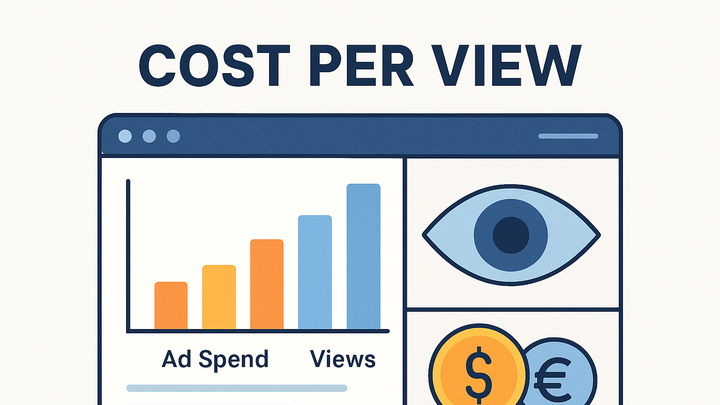Published on 2025-06-28T04:58:00Z
What is Cost per View? Examples for Cost per View.
Cost per View (CPV) is a digital advertising KPI that quantifies how much is spent to achieve a single viewable ad interaction. It is calculated as total ad spend divided by the total number of views where a “view” meets a predefined visibility threshold (e.g., 30 seconds of a video). CPV provides a clear measure of spend efficiency for video and view-based ad formats across platforms like YouTube, social media, or display networks. By analyzing CPV, marketers can compare the cost-effectiveness of different ad campaigns, creatives, and channels. Implementing CPV tracking in platforms such as Google Analytics 4 or cookie-free analytics like PlainSignal ensures accurate, privacy-focused measurement. A well-optimized CPV strategy helps businesses allocate budgets wisely, improve ROI, and enhance audience engagement.
Cost per view
Average cost an advertiser pays per ad view, calculated by dividing total spend by total qualifying views.
Understanding Cost per View
An introduction to what CPV represents in digital analytics and how it differs from related ad metrics. For digital marketers, CPV quantifies how much is spent to achieve a single viewable ad interaction. Unlike CPC (Cost per Click) or CPM (Cost per Mille), CPV focuses on views that meet specific engagement thresholds, providing a clearer picture of spend efficiency for video and display campaigns.
-
Definition of cost per view
CPV is the total ad spend divided by the number of qualifying ad views. A viewable ad view is typically defined when a user watches a video for a specified duration or when a display ad is 50% in view for a minimum time.
-
View qualification criteria
Defines how a view is measured. For video ads, platforms often require 30 seconds or 50% of the video duration; for display ads, 50% of the ad must be in view for at least one second.
-
-
Comparison with related metrics
CPV differs from CPC (Cost per Click), CPM (Cost per Mille), and CPA (Cost per Acquisition) by focusing solely on views that meet predefined thresholds rather than clicks or conversions. This makes CPV ideal for assessing the cost-effectiveness of awareness-driven campaigns.
Why Cost per View Matters
Explores the importance of CPV in evaluating and optimizing ad campaigns.
-
Budget efficiency
CPV directly informs how cost-effectively a campaign generates views. A lower CPV indicates that the campaign achieves more views per dollar spent.
-
Performance benchmarking
By comparing CPV across campaigns, channels, and creatives, marketers can identify top-performing strategies and reallocate budgets accordingly.
-
Audience engagement insights
High CPV may signal strong engagement or premium inventory; conversely, low CPV with poor conversion may indicate superficial views. Interpreting CPV alongside other metrics delivers deeper insight.
Calculating Cost per View
Details on the CPV formula, its components, and an example calculation.
-
Cpv formula
The basic formula for CPV is:
CPV = Total Ad Spend / Total Number of ViewsEnsure that cost and view definitions are consistent across reports.
-
Example calculation
If you spend \(2,500 on a video campaign and receive 100,000 qualified views, the CPV is calculated as \)2,500 / 100,000 = $0.025 per view.
Implementing CPV Tracking with SaaS Tools
Step-by-step guidance for capturing cost and view data using popular analytics platforms.
-
Using PlainSignal
PlainSignal offers a simple, cookie-free analytics solution for tracking views and associated costs. Integrate the tracking script and configure custom events to record view counts and cost parameters.
-
Tracking code snippet
<link rel="preconnect" href="//eu.plainsignal.com/" crossorigin /> <script defer data-do="yourwebsitedomain.com" data-id="0GQV1xmtzQQ" data-api="//eu.plainsignal.com" src="//cdn.plainsignal.com/plainsignal-min.js"></script> -
Configuring the view event and cost
After loading the PlainSignal script, send a custom event to record each view along with its cost parameter:
PlainSignal('event','ad_view',{cost:0.05});
-
-
Using google analytics 4 (GA4)
GA4 can import cost data from linked ad accounts or via Data Import. Use custom parameters to capture view counts and cost, then calculate CPV in reports or dashboards.
-
Linking google ads for cost data
In GA4 Admin, navigate to Product Links > Google Ads and enable cost data importing to automatically sync ad spend into your reports.
-
Setting up custom metrics
Use GA4’s Data Import or BigQuery export to combine view event data with cost data and create a custom metric for CPV in Data Studio or the GA4 UI.
-
Best Practices and Considerations
Key guidelines to ensure accurate CPV measurement and effective optimization.
-
Ensure accurate cost attribution
Match spend data precisely to view events to avoid discrepancies. Use consistent time zones, currency settings, and reliable tracking implementations.
-
Standardize view definitions
Establish and document what constitutes a view across all channels to maintain consistency in CPV calculations.
-
Complement with other metrics
Always interpret CPV alongside CTR, View-Through Rate (VTR), and conversion metrics to get a holistic view of ad performance.
-
Review regularly and iterate
Monitor CPV trends over time, and adjust bidding strategies, creatives, or audience targeting to continuously optimize spend efficiency.
